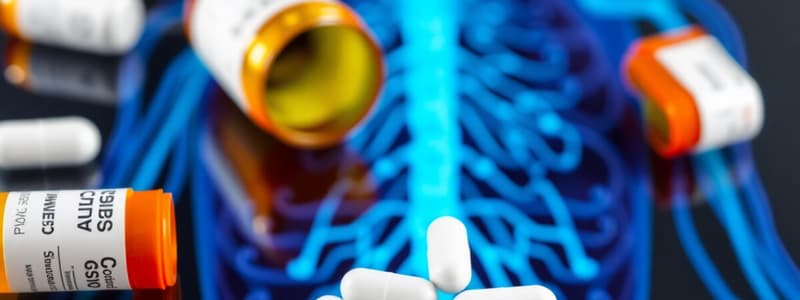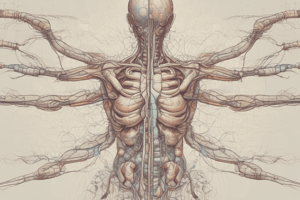Podcast
Questions and Answers
What is the primary action of mixed-acting sympathomimetics?
What is the primary action of mixed-acting sympathomimetics?
- Inhibit the effects of alpha receptors
- Reduce blood pressure by vasodilation
- Stimulate adrenergic receptor sites and release norepinephrine (correct)
- Block the release of norepinephrine
Which of the following drugs is classified as an alpha 1 agonist?
Which of the following drugs is classified as an alpha 1 agonist?
- Dopamine
- Clonidine
- Albuterol
- Phenylephrine (correct)
Which of the following is an indication for using alpha 1 agonists?
Which of the following is an indication for using alpha 1 agonists?
- Heart failure
- Severe bronchial asthma
- Nasal congestion (correct)
- Chronic obstructive pulmonary disease
What is a significant nursing consideration for the use of midodrine?
What is a significant nursing consideration for the use of midodrine?
What mechanism of action do alpha 1 agonists primarily utilize?
What mechanism of action do alpha 1 agonists primarily utilize?
What common side effect may occur with the use of midodrine?
What common side effect may occur with the use of midodrine?
How should blood pressure be monitored when administering an alpha 1 agonist?
How should blood pressure be monitored when administering an alpha 1 agonist?
Which of the following statements about alpha 1 agonists is incorrect?
Which of the following statements about alpha 1 agonists is incorrect?
What is the primary role of the autonomic nervous system (ANS)?
What is the primary role of the autonomic nervous system (ANS)?
Which division of the autonomic nervous system is responsible for the 'fight or flight' response?
Which division of the autonomic nervous system is responsible for the 'fight or flight' response?
From which region of the spinal cord does the sympathetic nervous system arise?
From which region of the spinal cord does the sympathetic nervous system arise?
What type of responses do adrenergic receptors primarily mediate?
What type of responses do adrenergic receptors primarily mediate?
What distinguishes adrenergic agonists from antagonists?
What distinguishes adrenergic agonists from antagonists?
Which of the following is NOT a major response to stimulation of the autonomic nervous system?
Which of the following is NOT a major response to stimulation of the autonomic nervous system?
What is the primary characteristic of the somatic nervous system compared to the autonomic nervous system?
What is the primary characteristic of the somatic nervous system compared to the autonomic nervous system?
Which statement about alpha and beta antagonists is incorrect?
Which statement about alpha and beta antagonists is incorrect?
What is the primary mechanism of action of alpha-2 agonists?
What is the primary mechanism of action of alpha-2 agonists?
What is a potential side effect of sudden discontinuation of alpha-2 agonist treatment?
What is a potential side effect of sudden discontinuation of alpha-2 agonist treatment?
What is the maximum daily dose for oral administration of the alpha-2 agonist used for treating hypertension?
What is the maximum daily dose for oral administration of the alpha-2 agonist used for treating hypertension?
Which nursing consideration is crucial when administering alpha-2 agonists?
Which nursing consideration is crucial when administering alpha-2 agonists?
For what condition is the alpha-2 agonist typically indicated?
For what condition is the alpha-2 agonist typically indicated?
What vital sign measurement is particularly important after the patient has been lying down?
What vital sign measurement is particularly important after the patient has been lying down?
What dosage adjustment may be needed for an alpha-2 agonist based on patient condition?
What dosage adjustment may be needed for an alpha-2 agonist based on patient condition?
What should be monitored regularly during IV infusion of an alpha-2 agonist?
What should be monitored regularly during IV infusion of an alpha-2 agonist?
What is the primary effect of indirect-acting cholinergic agonists?
What is the primary effect of indirect-acting cholinergic agonists?
What is the primary mechanism of action for alpha 1 antagonists in the treatment of BPH?
What is the primary mechanism of action for alpha 1 antagonists in the treatment of BPH?
Which drug is classified as a direct-acting muscarinic agonist?
Which drug is classified as a direct-acting muscarinic agonist?
What is a common effect of cholinergic agonists on the cardiovascular system?
What is a common effect of cholinergic agonists on the cardiovascular system?
Which nursing consideration is essential before starting treatment for benign prostatic hyperplasia (BPH)?
Which nursing consideration is essential before starting treatment for benign prostatic hyperplasia (BPH)?
What risk is associated with the use of yohimbine as an alpha 2 antagonist?
What risk is associated with the use of yohimbine as an alpha 2 antagonist?
Which of the following is an effect of anticholinergic drugs?
Which of the following is an effect of anticholinergic drugs?
What effect do nonselective beta blockers have on patients with COPD or asthma?
What effect do nonselective beta blockers have on patients with COPD or asthma?
Which of the following drugs is utilized for treating Alzheimer's disease?
Which of the following drugs is utilized for treating Alzheimer's disease?
What is the main therapeutic use of the drug Rivastigmine?
What is the main therapeutic use of the drug Rivastigmine?
Which beta blocker is classified as selective for beta1 receptors?
Which beta blocker is classified as selective for beta1 receptors?
Which of the following statements about the effects of cholinergic agonists is true?
Which of the following statements about the effects of cholinergic agonists is true?
How do beta adrenergic antagonists primarily affect cardiac output and workload?
How do beta adrenergic antagonists primarily affect cardiac output and workload?
What is the effect of cholinergic agonists on ocular function?
What is the effect of cholinergic agonists on ocular function?
What is the role of cAMP in smooth muscle relaxation and airway function?
What is the role of cAMP in smooth muscle relaxation and airway function?
What should be monitored 2 to 3 hours after the initial dose of an alpha 1 antagonist?
What should be monitored 2 to 3 hours after the initial dose of an alpha 1 antagonist?
Flashcards are hidden until you start studying
Study Notes
ANS Drugs
- The Autonomic Nervous System (ANS) regulates involuntary bodily functions like heart rate, digestion, and respiration
- The ANS has two divisions: the sympathetic nervous system (SNS) and the parasympathetic nervous system (PNS)
- The SNS prepares the body for 'fight or flight' responses, it readies the body for threats
- The sympathetic nervous system arises from the thoracolumbar region of the spinal cord
- Alpha-1 Agonists: Epinephrine, Ephedrine, Dopamine, Phenylephrine, Midodrine
- These medications are used for nasal congestion, hypotension, and pupillary dilation
- They activate α1-adrenoceptors in the nasal mucosa and arterioles, causing vasoconstriction and increased blood pressure
- Alpha-2 Agonists: Clonidine, Methyldopa
- These medications are used for hypertension and pulmonary hypertension
- They stimulate alpha-2 adrenoreceptors in the brainstem, leading to reduced sympathetic outflow and decreased blood pressure
- Beta-1 Agonists: Epinephrine, Ephedrine, Dopamine, Dobutamine, Isoproterenol
- These medications stimulate beta-1 receptors
- Beta-2 Agonists: Epinephrine, Ephedrine, Isoproterenol, Albuterol, Terbutaline, Metaproterenol
- These medications stimulate beta-2 receptors
- Mixed Agonists: Epinephrine, NE, Ephedrine, Dopamine, Pseudoephedrine
- These medications stimulate both alpha and beta receptors
- Beta Adrenergic Antagonists (-olols)
- These medications are also known as beta blockers, they decrease heart rate and blood pressure
- Nonselective beta blockers block both beta1 and beta2 receptors, should be used with caution in patients with asthma and COPD
- Examples: Carvedilol, Labetalol, Propranolol, Nadolol, Pindolol, Sotalol, Timolol
- Selective beta blockers have a greater affinity for certain receptors, and are used to decrease pulse rate and blood pressure
- Examples: Atenolol, Metoprolol tartrate
- Cholinergic Agonists
- These drugs increase the action of acetylcholine by stimulating the receptors
- Types of cholinergic agonists:
- Direct-acting Cholinergic Agonists: Acetylcholine, Bethanechol, Carbachol, Pilocarpine, Cevimeline, Nicotine, Varenicline, Lobeline, Succinylcholine, Suxamethonium chloride
- **Indirect-acting Cholinergic Agonists: ** Edrophonium, Carbamates (-stigmines), Organophosphates, Rivastigmine, Donepezil, Galantamine, Tacrine
Cholinergic Agonists
- Their effects on the body include:
- Decreased heart rate, decreased blood pressure
- Increased tone and motility of smooth muscle of the stomach and intestine, increased peristalsis, and relaxed sphincter muscles
- Contraction of muscles of the urinary bladder, increased tone of ureters, relaxed bladder sphincter muscles, and stimulated urination
- Increased pupil constriction (miosis) and increased accommodation (flattening or thickening for distant or near vision)
- Increased salivation, perspiration, and tears
- Stimulation of bronchial smooth muscle contraction and increased bronchial secretions
- Increased neuromuscular transmission and maintenance of muscle strength and tone
Cholinergic Antagonists
- Also known as parasympatholytics or anticholinergics
- They inhibit the actions of acetylcholine by occupying the acetylcholine receptors
- They produce the following effects:
- Decrease in GI motility
- Decrease in salivation
- Mydriasis
- Increase in pulse rate
Studying That Suits You
Use AI to generate personalized quizzes and flashcards to suit your learning preferences.




